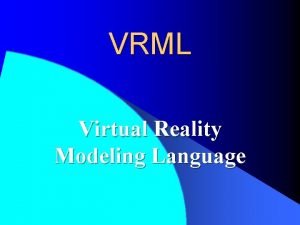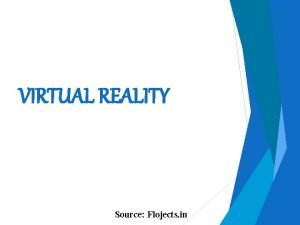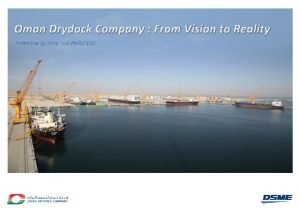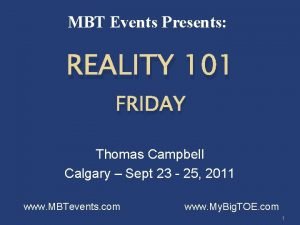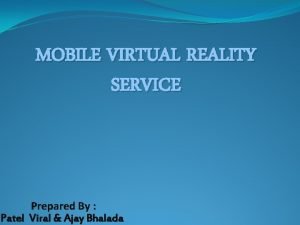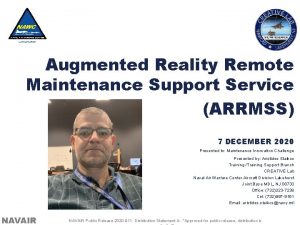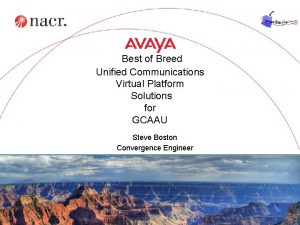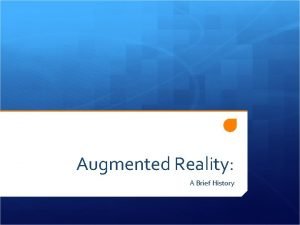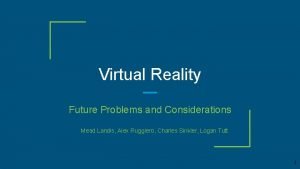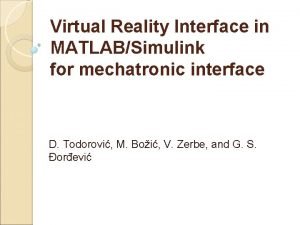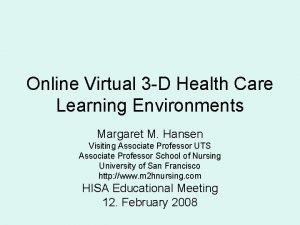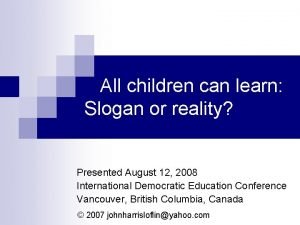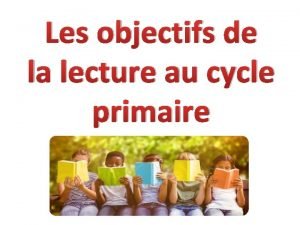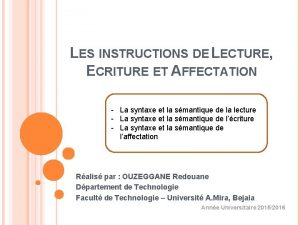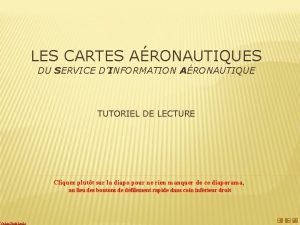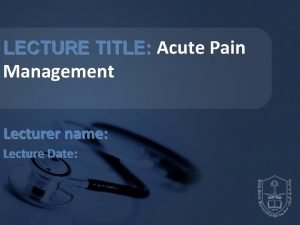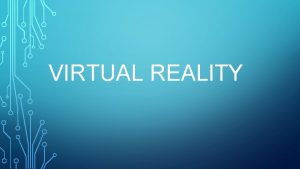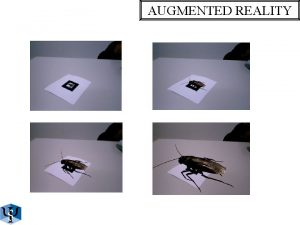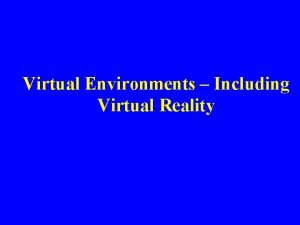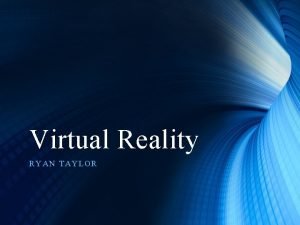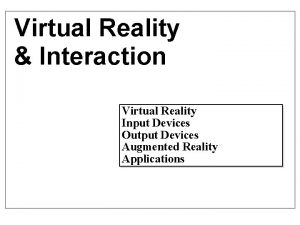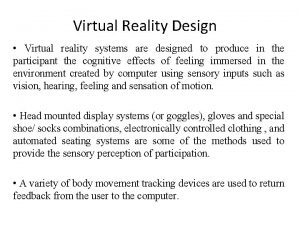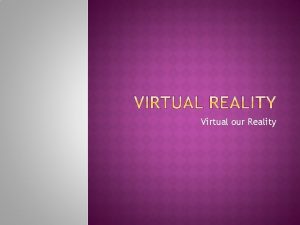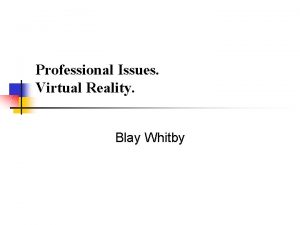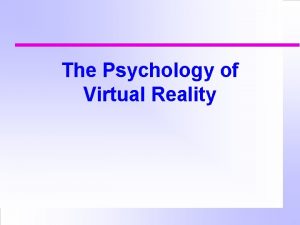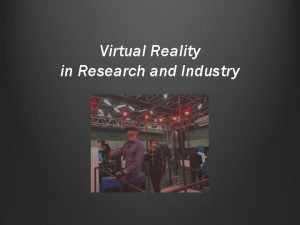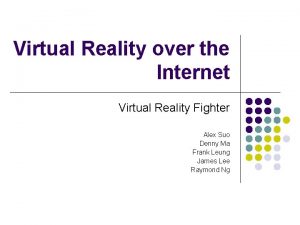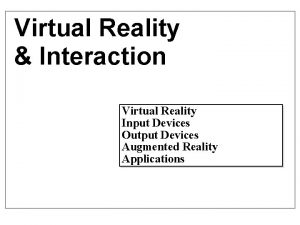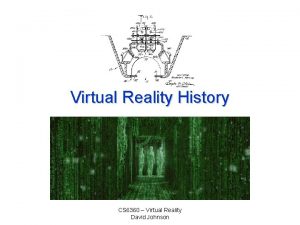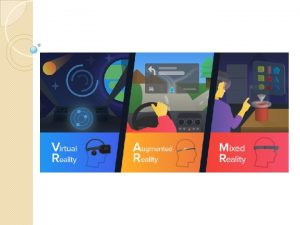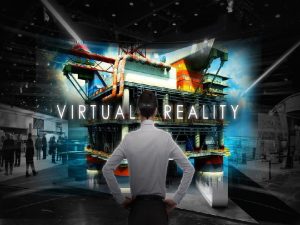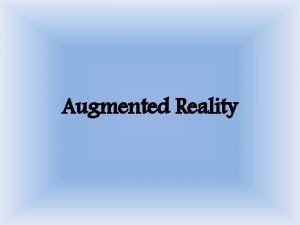Lecture 1 Introduction to Virtual Reality Virtual Reality




















































- Slides: 52

Lecture 1. Introduction to Virtual Reality 고려대학교 그래픽스 연구실 Virtual Reality

Contents • • • What is VR? Conceptual Model of VR VR Related Areas History State of the Art and R&D Issues Some Application Examples

Science vs. Engineering • What is not VR. • high road - replication of reality low road - 3 -D interface / interaction • VR = studies on reality • analogous to AI – lots of hypes – AI as a science / engineering computational reality

What is not VR.

• VR as computational reality – To seek for the computational model of reality. – To apply the model to the VR system. • VR can be understood in the context of modeling efforts. – – – intelligence linguistics emotion life reality compuational “X”

Definition : What is VR? • Computer generated environment that is … – Immersive (like IMAX, dome projection), – Interactive (like computer game), – Multi-sensory, – Viewer-centered, – 3 -D, and – The combination of technologies required to build such environments.

VR as a computer technology • Technological trend – powerful – smart – physical • computer - human interaction • primary concern --- software other important issues --- hardware, human factors, social issues, infrastructure

Interacting with computers Computer World

New Paradigm for HCI Conventional Computer World VR-based Computer World

VR as a media • All medium attempt to create the “virtual presence”. – Theater, poem, fine arts, novel, telephone, movies, TV, . . . • VR vs. existing media – – – immersive interactive 3 -D multimodal mediated • Information is not sent back and forth. • Mediated environments are created and then experience.

• effectiveness of communication depends on. . . the sense of “being there”. • virtual presence depends on. . . – sensory breadth – sensory depth – interactivity

VR Application Education/ Training Design Engineering Entertainment Museum Arts VR application Scientific Visualization Medicine Communication Products Engineering

VR technologies Character CRT Computer graphics Graphic CRT Realtime CG Virtual console Keyboard Mouse tablet 3 D mouse Computer simulation/ visualization Virtual Reality Video arts Virtual products design 3 D CAD Computer Aided Design Tele-conference Tele-Existence TV phone Tele-Operation Telephone All technologies meet together at VR !!

VR in Real World vs. Virtual World Tele-Existence in Real World Virtual Reality • Standard Tele-Existence • Augmented Tele-Existence • Size • Sensation • Time • Physical World Tele-Existence in • Quasi Physical World Virtual World • Non Physical World


Conceptual Model of VR Display system • 3 D image Large-scale display, Head Mounted Display • Sound field by DSP • Force beedback mechanism • Tactile display Computer Simulation System Human Sensing system • Non-contact type magnetic field supersonic wave infrared light • Contact type optical fiber strain gauge potentio-meter

VR Related areas 1. Training simulation 2. Tele-operation 3. Computer graphics 4. Artificial intelligence

Training simulation • Differences – – reconfigurable by changing software may include highly unnatural environment highly interactive and adaptive use of a wide varielty of human sensing modalities and sensorimotor systems – highly immersive – near-field is synthetic; far-field is synthetic.

Tele-operation • for at least 30 years. • Tele-operator – directly (manually) controlled tele-operator – tele-robot • Tele-operation vs. Virtual reality • Tele-presence vs. Virtual presence

Computer graphics • • Modeling Motion control (animation) Rendering User interface

Artificial intelligence • Studies on perception and cognition • Testbed for AI research

History • 1’st stage: some visionaries – – Morton Heilig : Experience. Theatre(1962) Ivan Surtherland : Sketchpad(1963), HMD(1966) Myron Krueger : Artificial Reality(1972) William Gibson : “Cyberspace” in Neuromancer(1984) • 2’nd stage: technology development for specific purposes – training simulator : Earlier works – space exploration : NASA for astronaut simulation – tele-operation

History(con’t) • 3’rd stage: VR as the general-purpose technology – Jaron Lanier : VPL(1987) – Dataglove, Eye. Phone, VR system – VR industry : Division Ltd. Sense 8, World. Design(production house, W-Industry(game) – VR academia : MIT, UNC, UW, Tokyo U. • Next stage: Toward a scientific discipline – – – computational reality a new computing paradigm a new media a new art form representation, creation and operation of virtual worlds

State of the Art & Issues • Reference – Virtual Reality: Scientific and Technological Challenges”, pp. 35 -66, National Research Council, National Academic Press, 1995. • Areas of the study – – application domains psychological issues VR technologies evaluation of VR systems

1. Application domains • • • design, manufacturing & marketing medicine, health care hazardous operations training entertainment, military experimental psychology education information visualization tele-communication, tele-travel

2. Psychological topics • human performance characteristics • alteration of sensori-motor loops • developing the cognitive model • cognitive side-effect

3. VR technologies • Gap between the current technology the required technology (exception -- entertainment, tele-operation) (1) human-machine interface (2) computer generation of VE (3) tele-robotics (4) network

Human-machine interface (cont’) • • visual channel auditory channel haptic channel motion interface position tracking video camera microphone others

Visual channel • visual display – HMD – OHD (off-head display) • perceptual effects – – – mis-registration sensori-motor alteration distortion time-delay noise

• research issues – – – – ergonomics improvement of resolution and fov wireless integration of visual, auditory, position tracking sun glass-like see-through option exploiting foveal and peripheral vision

Auditory channel • Current hardware is adequate. • Research issues – perceptual issues • similar to the visual channel • use for sensory substitution (for visual, haptic) – auditory scene analysis – hear-through display

Position tracking and mapping • tracking = finding a point mapping = finding a 3 D surface (e. g. , environmental mapping) • tracking mechanisms – – – mechanical linkage magnetic optical acoustic intertial

• eye tracking • research issues – tracking – mapping

Haptic channel • force, pressure, tactile feedback • unique characteristics – Haptic interface requires manipulation and sensing • mechanism – body-based -- glove, exoskeleton – ground-based -- joystick

• Research issues – haptic science = study on the human haptics (bio-mechanical, psychophysical, cognitive) – tool-hand system (which takes its metaphor from real tools. ) – creating the haptic illusion – the interaction effects of haptic and vision – texture, temperature devices

Motion interface • motion – whole-body motion • passive -- e. g. , motion platform • active -- e. g. , locomotion – part-body motion • passive • active

• motion cues – – – vestibular system -- inertial motor visual auditory proprioceptive / kinesthetic -- muscle tactile

• motion interface – inertial system • moves the body (e. g. , treadmill, motion platform) – non-inertial system • simulates motion

Other types of interfaces • olfactory (smell) • gustatory (taste) • heat, wind, humidity • speech • direct physiological sensing and control

VR technologies (1) human-machine interface (2) computer generation of VE (3) tele-robotics (4) network

(2) Generation of virtual environments Display system • 3 D image Large-scale display, Head Mounted Display • Sound field by DSP • Force beedback mechanism • Tactile display Computer Simulation System Human Sensing system • Non-contact type magnetic field supersonic wave infrared light • Contact type optical fiber strain gauge potentio-meter

Generation of VE(cont’) • the core issue • general-purpose VR system? • trade-off between realism and interactivity • requirements – frame rate – response time – scene quality

Generation of VE(cont’) • hardware • interaction and navigation • VE management – simulation – rendering • • modeling autonomous agent hypermedia interaction OS

VE management - simulation • Task : simulating everyday world • Traditional simulation methods do not work. (requires pre-processing) • Need : “meta-modeling”

VE management rendering • Issue : load balancing – 1. partitioning VE – 2. LOD • Much work has been done on static scene. • Research issues – 1. dynamic scene – 2. parallel rendering

OS • real-time, multi-modal requirements • very high-resolution time slicing • atomic, transparent distribution of tasks • large number of light-weighted processors, communicating by means of shared memory • support for time-critical computing: – negotiated, graceful degradation – guaranteed frame rate, lag time

VR technologies (1) human-machine interface (2) computer generation of VE (3) tele-robotics (4) network

(3) Tele-robotics • tele-robotics and VR • hardware • time-delay problem • distributed tele-robots

(4) Network • The future is here! • applications – – distance learning group entertainment distributed training distributed design • current • future • What is needed

Research Organizations International Efforts U. S. A. medicine U. K. Germany Japan HDTV. defense, space, visualization, education, training, entertainment VR as a logical extension of robotics, automation,

Academia • • • HIT Lab, University of Washington University of North Carolina Media Lab, MIT Georgia Institute of Technology Naval Postgraduate School University of Pennsylvania University of California at Berkeley University of Illinois - Chicago Columbia University of Toronto

And, Some VR Example… (Video)
 01:640:244 lecture notes - lecture 15: plat, idah, farad
01:640:244 lecture notes - lecture 15: plat, idah, farad Virtual reality modeling language
Virtual reality modeling language Input devices for virtual reality
Input devices for virtual reality Oman drydock company logo
Oman drydock company logo Tom campbell virtual reality
Tom campbell virtual reality Virtual reality business cards
Virtual reality business cards Virtual reality modeling language
Virtual reality modeling language Mobile virtual reality service
Mobile virtual reality service Virtual reality remote maintenance
Virtual reality remote maintenance Virtual reality unified communications
Virtual reality unified communications Ivan sutherland hmd
Ivan sutherland hmd Conclusion for virtual reality
Conclusion for virtual reality Conclusion of virtual reality
Conclusion of virtual reality Virtual reality joke
Virtual reality joke Pros and cons of virtual reality in healthcare
Pros and cons of virtual reality in healthcare All children can learn slogan
All children can learn slogan Introduction to biochemistry lecture notes
Introduction to biochemistry lecture notes Introduction to psychology lecture
Introduction to psychology lecture Introduction to algorithms lecture notes
Introduction to algorithms lecture notes Has virtual functions and accessible non-virtual destructor
Has virtual functions and accessible non-virtual destructor Intro paragraph layout
Intro paragraph layout Project procurement management lecture notes
Project procurement management lecture notes Lecture about sport
Lecture about sport Healthy lifestyle wrap up lecture
Healthy lifestyle wrap up lecture Whats nihilism
Whats nihilism Meaning of this
Meaning of this Randy pausch the last lecture summary
Randy pausch the last lecture summary Tensorflow lecture
Tensorflow lecture Theology proper lecture notes
Theology proper lecture notes Strategic management lecture
Strategic management lecture Geology lecture series
Geology lecture series Social psychology lecture
Social psychology lecture In text citation for a lecture
In text citation for a lecture Define public sector accounting
Define public sector accounting Project management lecture notes
Project management lecture notes Practical design to eurocode 2
Practical design to eurocode 2 Magnetism
Magnetism Classical mechanics
Classical mechanics What is a harmonic wave in physics
What is a harmonic wave in physics Physical science lecture notes
Physical science lecture notes Power system dynamics and stability lecture notes
Power system dynamics and stability lecture notes Natural language processing
Natural language processing Microbial physiology lecture notes
Microbial physiology lecture notes Mechatronics ppt
Mechatronics ppt Limits fits and tolerances lecture notes
Limits fits and tolerances lecture notes Lecture primaire
Lecture primaire Instruction de lecture et d'écriture
Instruction de lecture et d'écriture Aronautique
Aronautique Lecture title
Lecture title Slidetodoc
Slidetodoc Money-time relationship and equivalence
Money-time relationship and equivalence Bjt transistor notes
Bjt transistor notes Requirement analysis in software engineering notes
Requirement analysis in software engineering notes

